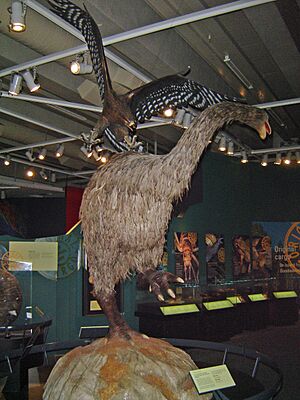Folk memory facts for kids
Folk memory is like a super old story that people have told each other for many, many years. It's also called folklore or myths. These stories are about things that happened a long, long time ago. We're talking hundreds, thousands, or even tens of thousands of years!
These memories often explain things about a local area. They might tell why a mountain looks a certain way. Or they could explain why a group of people has a special tradition. Sometimes, they even tell us how a place got its name. It's like history passed down through talking, not writing.
Stories from Long Ago
Folk memories can be about big events or even animals that lived long ago. Scientists and historians study these stories. They try to see if the stories match up with real events or creatures from the past.
Events People Remembered
- One story is about Willem Janszoon. He was the first European to see Australia's coast in 1606. This event, the landing at Cape York, might be part of local folk memories.
- Some Native American and First nations groups have myths. These myths might describe the huge Cascadia earthquake of 1700.
- The Finnish national epic Kalevala tells about the origin of fire. This story might come from a meteorite hitting Kaali crater in Estonia. This impact happened 4,000 to 7,600 years ago.
- Many cultures have Great Flood myths. Some think these stories might remember a real flood. This could be the flooding of the Black Sea basin around 5600 BCE.
- The Klamath Indian myth talks about the eruption of Mount Mazama. This volcano erupted around 5700 BCE.
Animals in Old Stories
Sometimes, folk memories describe animals that are now extinct. People might have seen these creatures long ago.
- Māori legends tell of a huge, man-eating bird. It's called the Pouākai, Hokioi, or Hakawai. Many believe these stories are about the Haast's eagle. This giant bird died out with the moa only 600 years ago.
- The Mapinguari legends describe a giant sloth-like creature. This sounds like the Megatherium, which became extinct 10,000 years ago.
- Australian Aboriginal mythology has legends of the bunyip. These stories have been linked to extinct marsupials. Examples include Zygomaturus or Palorchestes. Some Aboriginal people identified fossils of these animals as bunyips.
- Western Victorian Aboriginal peoples describe the mihirung paringmal. This description matches the extinct giant birds called Dromornithidae.
- A Noongar Aboriginal story from Perth, Western Australia, might be about the extinct giant monitor lizard Megalania.
- Legends across Eurasia describe creatures like the unicorn. These might be based on the Elasmotherium. This rhinoceros is thought to have died out up to 50,000 years ago.
- The Ebu Gogo myths from the people of Flores might describe Homo floresiensis. This human species may have died out around 10,000 BCE.
- An Inuit string figure shows a large creature. Some believe it represents the extinct woolly mammoth.
- Many Native American tribes have legends that some think are about Woolly Mammoths. For example, the Kaska tribe from northern British Columbia told a story in 1917. It was about a very large, hairy animal like an elephant with tusks. They said people saw these animals not long ago.
It's important to remember that linking these old stories to real events or animals can be tricky. It takes a lot of careful study. Scientists often need to make educated guesses to fill in missing information. This is because these stories come from a time before writing existed.
See also
- Cultural memory
- Euhemerism
- Cryptozoology


